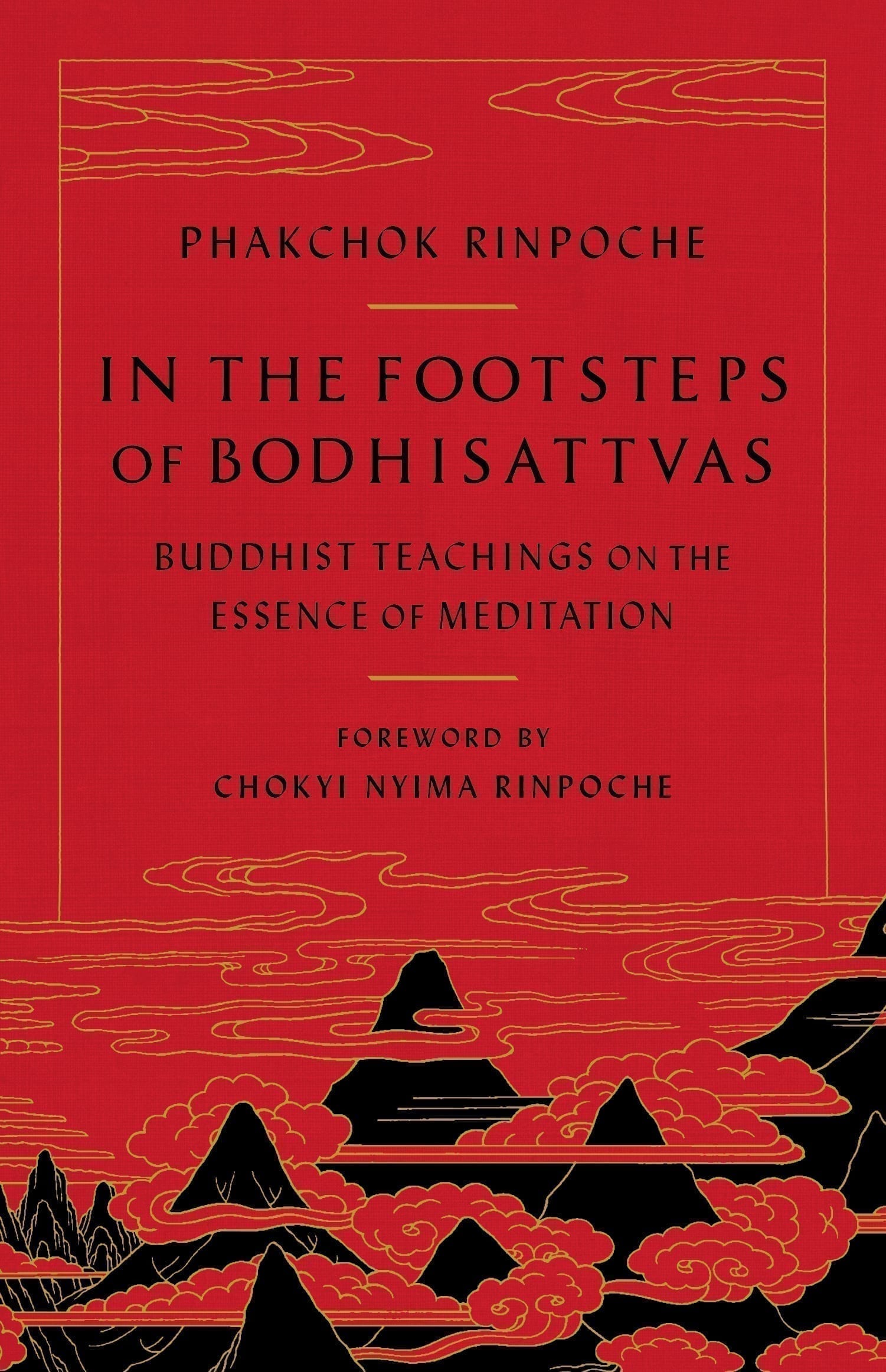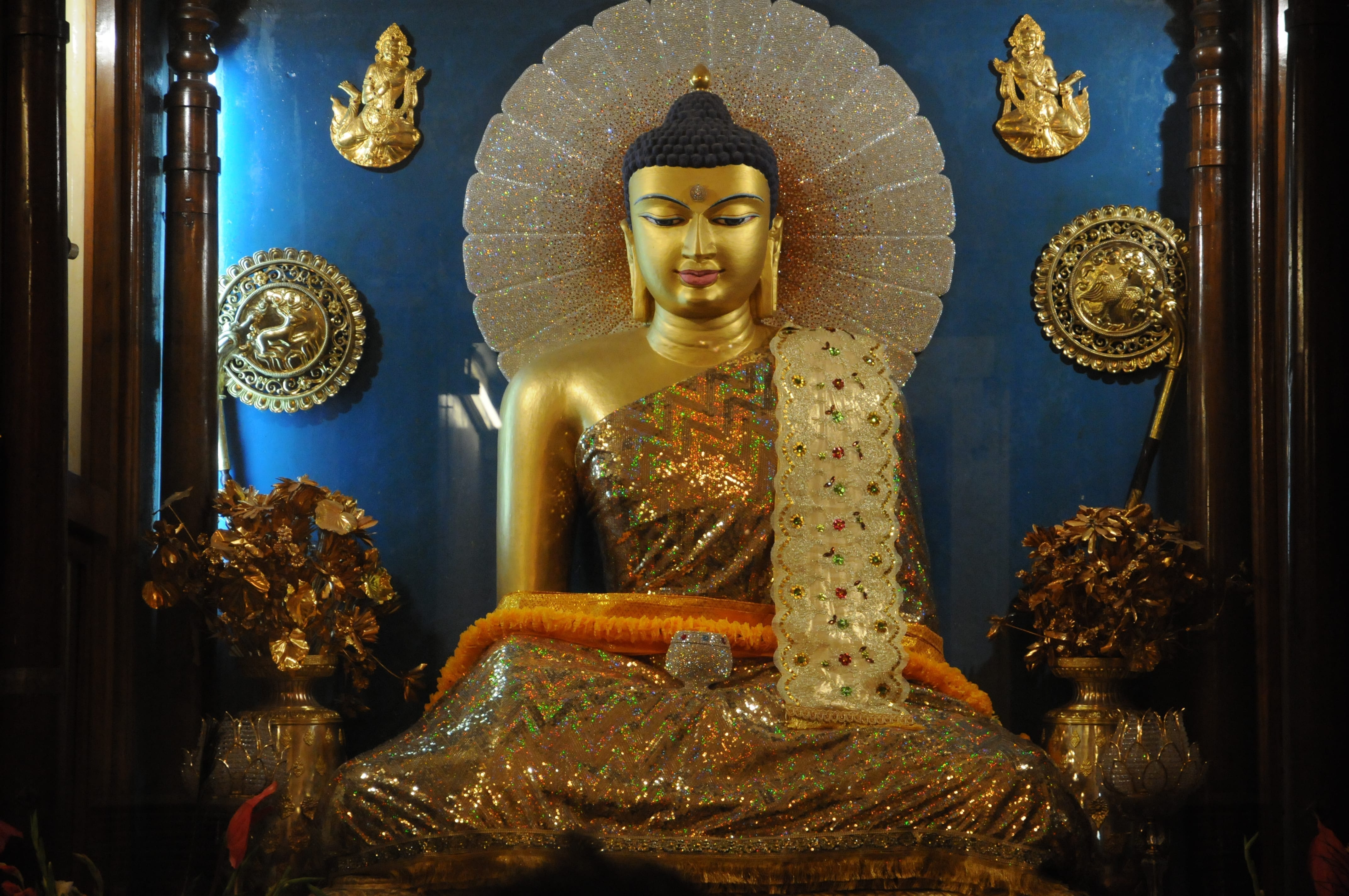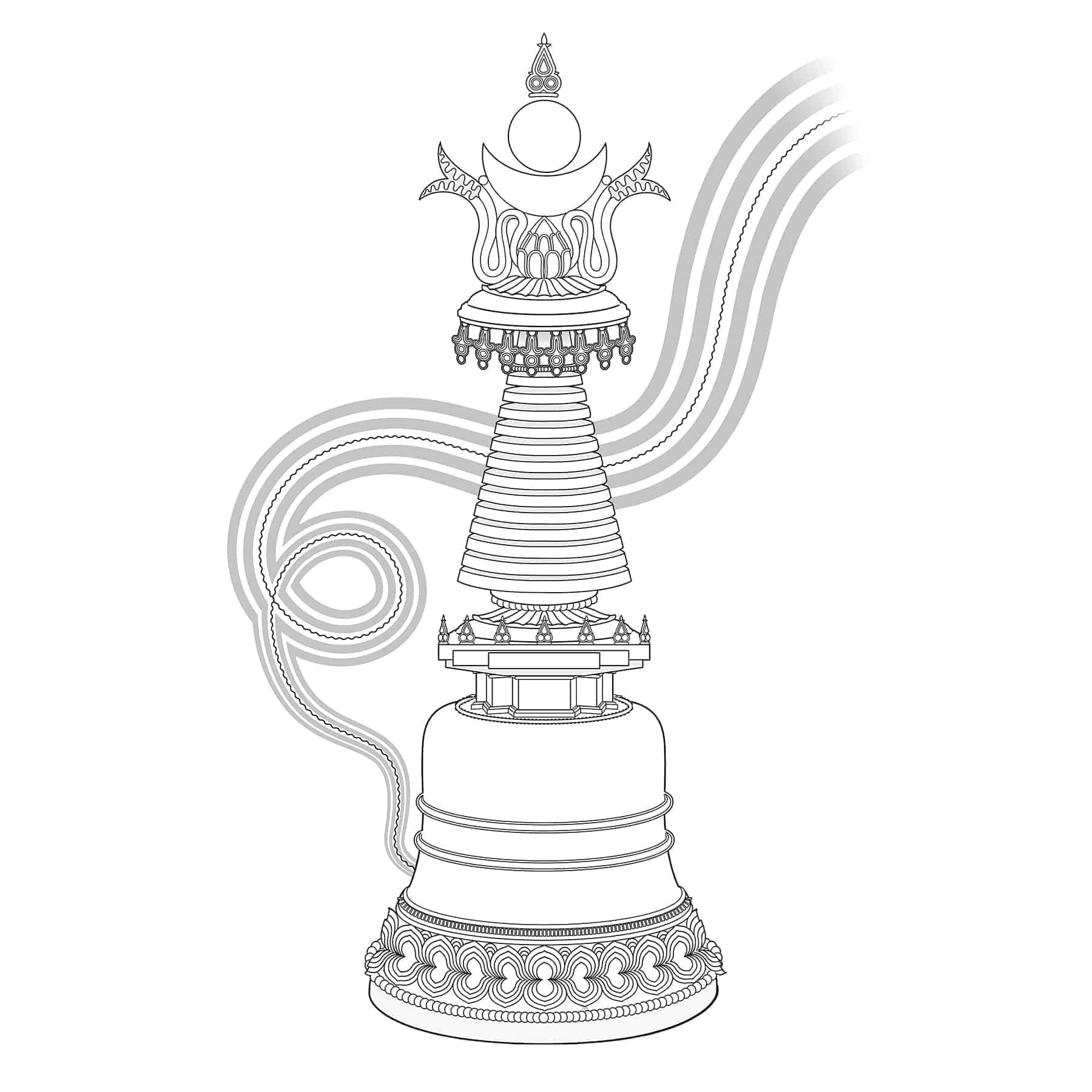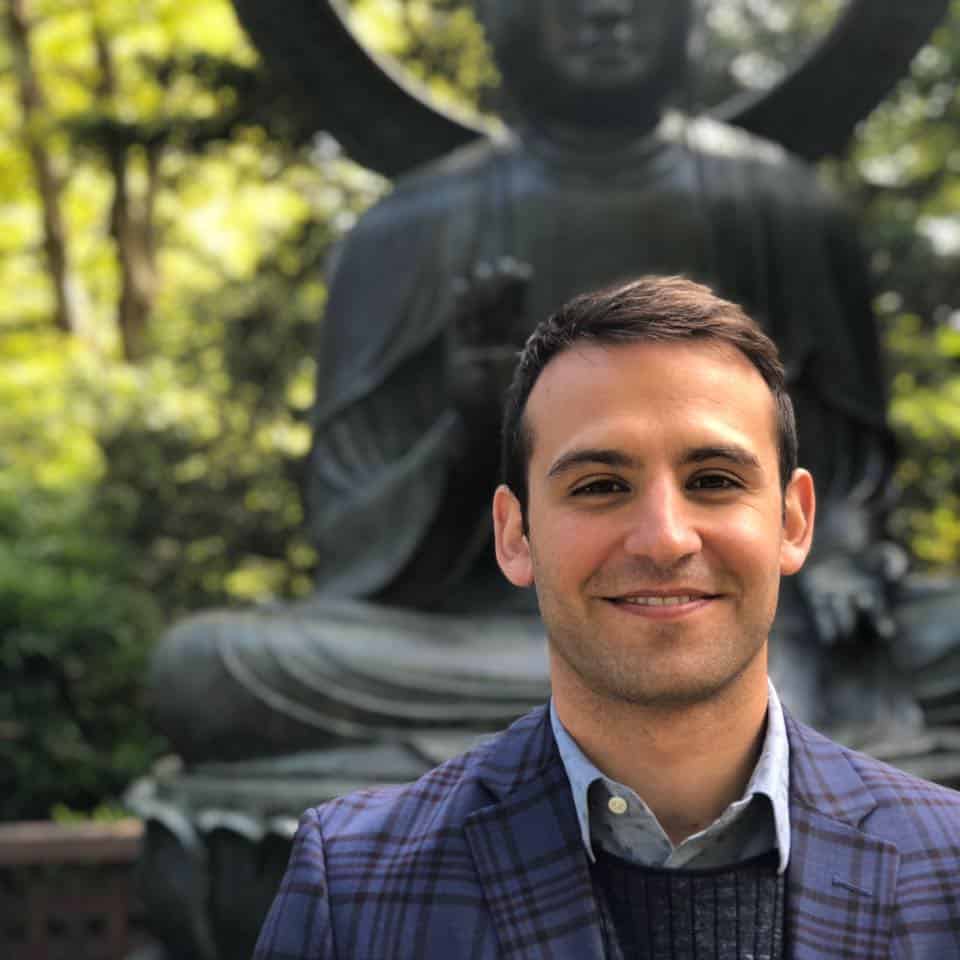Since the complexion of his body is like gold, the world protector is extremely beautiful in all respects. Whichever bodhisattva focuses his mind upon him is in meditative equipoise.
—from the Samadhiraja Sutra
Within In the Footsteps of Bodhisattvas, Phakchok Rinpoche clearly shows how genuine meditation is contingent upon bringing together many supportive conditions. However, Rinpoche also articulates methods for contained formal sessions that are effective, profound, and transformative. The power to enact a transformation of experience, eliminating suffering at the root, depends in large part upon the proper application of the methods that have been repeatedly employed to produce this result. As Rinpoche has indicated—we need to do what works, what has been proven to work, and not waste time playing mental games. In the Samadhiraja Sutra, the Buddha says that if we genuinely apply the correct techniques, awakening is not so far away.

To begin understanding this process, let’s not allow our eyes to slide casually over the word “transformative.” If we have not trained authentically in the context of a genuine lineage, it can be very hard to have a sense of how correct meditation practice can radically change the texture of our experience. Generally, we are habituated to a narrow perception of what constitutes physicality, of what it feels like to be in a body interacting with solid and substantial objects. Even if we are practitioners and have received teachings on the foundational and indispensable teachings of impermanence, as well as the twofold emptiness of the personal self and the self of phenomena, we can nonetheless slip into a sense of jadedness in which our practice produces what feel like light results again and again. We secretly suspect that our practice isn’t powerful enough to eclipse the clinging to self and phenomena and the negative habits which perpetuate our suffering. There can be a sense of “stuckness,” and we can come to think, as Phakchok Rinpoche says, “Maybe I can become a little happier—but enlightenment? Come on!”
Giving Up Glaring
This can feel especially true if we have received some instruction on the profound Mahamudra tradition, which includes instructions about giving up all activities other than unelaborate meditation. We can interpret this to mean that we don’t need any other methods at the moment, and then just sit on the cushion trying to glare our way into the natural state. I’ve tried it. Once, while I was “meditating” in a particularly determined mood, Phakchok Rinpoche glanced up at my focused face and just laughed. That moment of compassionate derision broke the momentum of effort, and there was indeed some opening. As a student sharing with my fellow Dharma students, many of whom have a lot more meditation experience than I do, I feel comfortable saying that whenever in the past I’ve felt a sense of stuckness and tried to force my way into unelaborate meditation, I’ve only just ended up with sore eyes and a headache.
This happens when we aren’t filling our lives with virtuous activities, and when we don’t understand the potential of our compassion. Our sense of what this mind can become hasn’t been urged into vastness. It’s like standing in the sand and looking at the ocean through a small metal tube, yearning to bodysurf in the little circle of the image. We don’t know we’re standing on this incredibly open shoreline of luminous sky and sea. We don’t have a sense of how free things actually are. All of the many methods that support unelaborate meditation exist to help us widen the diameter of tube through which we are viewing the sea, and then ultimately drop the tube and never pick it up again. By embracing the methods of the tradition, such as instructions on visualization practice, we start to experience a sober elation from intuiting the perfect openness of the ocean. We begin to understand that with a few steps toward the water and some good swimming lessons, we’ll be joyously bodysurfing a continuous outpouring of waves and discovering ever-increasing beautiful depths beneath the surface. When we look back at the narrowness with which we were viewing the sea, we might even laugh.
Phakchok Rinpoche teaches us that gathering merit, cultivating devotion, nurturing compassion, and conceptually resolving the view of emptiness are extremely important. He has said in many public teachings that these cultivations support the formal practices of shamatha (calm abiding) and vipashyana (special insight). So, knowing full well the importance of supportive practice, let’s take a look at the actual formal meditation instruction. Below, you will find the foundational techniques for moving through the stages of practice on the basis of visualizing Shakyamuni Buddha.
Formal Meditation
In accordance with every Buddhist tradition, Phakchok Rinpoche divides the two stages of practice into shamatha and vipashyana. That said, terminology applied in one tradition does not necessarily have the same meaning in another. In this tradition of practice, we have the option to “upgrade” sutric method into a tantric context. We are reading sutric teachings, utilizing the form of Shakyamuni Buddha, and talking about a linear progression to the realization of emptiness—which will work beautifully for someone who has not had the natural state pointed out by an authentic teacher. If we have already had the natural state of unified emptiness and compassion revealed to us, and we are taking that recognition as the basis of our training, the following progression will be of tremendous help in remaining within the recognition of the natural state.
Shakyamuni Buddha said that to sustain the view of emptiness is to become free from the effort of maintaining samadhi, yet to nonetheless remain in samadhi. There are essentially two stages within the practice of meditation that lead to this effortless sustaining. Our meditation practice first takes an object of support, then subsequently it does not.
— Phakchok Rinpoche
The shamatha in this tradition is very rich, very powerful. It is not void sedation—in the sense that it has nothing to do with becoming duller. We’re not “taking the edge” off, but rather learning to apply the edge in such a way that the fruits of stability, bliss, and intelligence flow out. Rather than paraphrase Phakchok Rinpoche’s meditation instruction, let’s look at some passages from In the Footsteps of Bodhisattvas.
Wealthy Shamatha
First, it’s helpful to create a flexible and lovely internal environment. This means saturating the mind with qualities like peace, fullness, and love. To do this effectively, Rinpoche encourages us to spend time visualizing Shakyamuni Buddha. So, sitting upright with crossed legs, back straight but body relaxed, chin slightly tucked in, shoulders gently back, hands either folded in the mudra of equanimity or palms-down on your knees, eyes open and at rest in the space before you, and with the tip of your tongue gently touching your palate, apply the visualization below:
We begin by visualizing the golden body of the Buddha and resting our attention upon that form. Imagine the Buddha appears in the sky before you upon a lotus throne. His shining body is immaculate—it is the most beautiful thing you have ever seen. Intentionally recollect his splendor. He is heavy and radiant with love and wisdom, and he directs his gaze at you. He is wide awake, free from judgment, compassionate, and omniscient. His wisdom light radiates out to you and to all beings. Endeavor in visualizing the Buddha, and the benefits will always follow you.
In this way, we spend time cultivating attention to Shakyamuni Buddha’s form. Rinpoche says that the visualization of the Buddha shouldn’t remain static—like a thangka painting or a statue. Visualize Shakyamuni Buddha as present, alive, and transcendent. His form is illusory but heavy with qualities, his mind omniscient and capable of apprehending you personally, in all your complexity and simplicity. Cultivate the feeling that the Buddha is inconceivably kind. There is nothing to hide in the presence of the Buddha’s love, which is utterly unconditional. In this context, to visualize the Buddha before you, vividly present, is the practice of shamatha with support.
It is very special to visualize Shakyamuni in this way. Through this practice you do develop mental calmness; but you also absorb all these different textures of virtue—love, bliss, dignity, altruistic intent, openness, clarity and other experiences—through attending to the Buddha’s form in meditation. If we are unable to visualize the entire form of the Buddha with vivid clarity, we can focus on the compassionate gaze of his eyes, or the radiant gold of his skin, or the light emitting from his form, or the silky and beautiful tuft of hair between his brows. We can recall his flexibility and his strength, his oceanic peace. As Lama Tsultrim Sangpo, senior chant master at Ka-Nying Shedrub Ling, once told me: “To visualize any part of the Buddha’s body is to receive the same blessings as visualizing the entire body of the Buddha.”

The qualities of the Buddha begin to flood into us, often with a pacifying effect. If this is an unfamiliar experience for you, think about it in this way: when you visualize the smell of an apple, its crunch and sweetness, there is an effect. There is a subtle sense of sweetness present in your mind, an invisible experience on your tongue. Isn’t it true? Once, Chokyi Nyima Rinpoche looked out at his students and said, “Sweet, sweet, sweet. Sour, sour, sour,” and then continued teaching. When we look at our minds in the moment of recollecting a quality, we see that there is the impression of that quality directly within our experience.
Similarly, when we meditate on the stability of the Buddha’s form, with all of its expressions of virtue, those qualities and virtues penetrate our experience. Impressions and seeds of altruism take root within us. If we do this continuously, with diligence and joy, we start to feel close to the Buddha. Then we start to see how the qualities that we are “getting” from visualizing the Buddha were always present within us. Phakchok Rinpoche tells us that we need to experience this inseparability more and more thoroughly. To do this, Rinpoche instructs:
Sustain this visualization and recall that the blissful nature of the Buddha is not separate from your own nature. This nature is unconditioned and causeless. Nobody made this causeless nature. When we have settled into this experience, we can let go into calm abiding without focus.
So, having given rise to a felt sense of sharing a sublime nature with the Buddha, we are ready to let go:
Abiding within the recognition that the nature of the Buddha is your nature, sustain the visualization of the Buddha for some time. Then, dissolve his form into space. As soon as you dissolve the visualization, rest in ease without focusing on anything whatsoever. Simply rest. This is shamatha, or calm abiding, without focus.
We dissolve the visualization and rest in an uncomplicated way. Rinpoche says that this is how we begin to practice emptiness.
Beginning Vipashyana
Resting in stable shamatha free from focus, ask yourself the question: “Who is holding this view?” Look for the observer. The observer is neither in nor out. When you cannot find where the observer arises, let go of looking.
Through this inquiry alone, we begin to see the mind as it is. We start to practice special insight. As this practice is very delicate and profound, I think it’s best to not go into this territory any more here—please read Phakchok Rinpoche’s teachings on this practice in In the Footsteps of Bodhisattva. Even better, try your best to make a connection with Phakchok Rinpoche or another authentic master, and receive these instructions in person. When we meet with a teacher who holds a genuine lineage and has realized the intent of the teachings, their presence, love, and wisdom allow these types of instructions to become very direct in the experience of the student.
Post-Meditation
If we practice with sincerity, we begin to feel close to the Buddha. Yet, since the Buddha is the fully manifest form of our own fundamental goodness, what we really begin to feel close to is the indestructible compassion and clarity that is the nature of our consciousness. With respect to our metaphor above, we are now waist deep in the waves and we start to experience the richness of our intrinsic wisdom. We feel the swirling sand around our feet and the cool water—a sense of space starts to open. We begin to contact nonconceptual wakefulness. In this way, again and again, our fixation on our problems and the rigidity of appearances in general starts to really loosen, and we naturally feel more freedom. The result of experiencing more freedom in this way is, very beautifully, an increase in compassion. The result of increased compassion enhances the sense of freedom, a more vivid experience of emptiness. So, we’re on our way.

To nurture our meditation and budding wisdom, Phakchok Rinpoche teaches us to recall the illusory nature of appearances. As a beginner, I have words for other beginners, which is to say that for us, the insubstantiality of phenomenon is not continuously vivid in post-meditation. So, Rinpoche teaches us to actively train in seeing phenomenon as illusions. Shakyamuni Buddha says in the Samadhiraja Sutra:
When the moon rises in a clear sky
and its reflection appears in a clear lake,
the moon did not enter the water.
Likewise, understand all phenomena to be defined in this way.
As the power of our meditation increases, this experience of illusory phenomena goes from fabricated to genuine. Rinpoche describes it in this way:
Through the power of insight, which comes from training in meditation again and again, you witness nothing actually present within the appearances of our world. You don’t fabricate the experience of phenomena being insubstantial, nor do you overlay “nothingness” onto the world. You look with the power of increasing insight and see that all is like the moon in the clear lake. This is why we say that everything is emptiness, peace, and stainless from the beginning. What is there to be stained?
When we begin to see like this, Rinpoche says we encounter the dharmakaya. So, through visualizing the Buddha we absorb the qualities of the Buddha. Through settling into those qualities, we let go into effortlessness. Within effortlessness, we see the nature of the mind. Through stabilizing the nature of the mind, the dharmakaya becomes more and more vivid. Through gaining full realization of the dharmakaya, we become Buddhas. It starts with visualizing the Buddha and ends with becoming a Buddha. This is why Rinpoche encourages us to take up the practice with a sense of confidence in the instruction and a sense of devotion for the fruition:
If the Buddha hadn’t attained realization, then the Dharma would not have flowed forth from his mouth. We turn toward the Buddha because the Buddha is the source of the Dharma. If you connect with the realization that radiates from the Buddha, you become the Buddha in that moment, and all buddhas praise you. When you sit in connection with that realization, countless buddhas bless you. This is an overwhelming feeling.
This is an outline of the formal meditation practice that Rinpoche teaches in In the Footsteps of Bodhisattvas. That said, Rinpoche’s teachings in the book overflow with even more precise and helpful instruction. There are ways to work with the visualization of the Buddha according to pith Mahamudra instructions, as well as methods for allowing the essence of the visualized Buddha to pervade the rest of appearances. There are also instructions on reconciling everything as dharmakaya without dissolving the visualization, along with helpful contemplations for sustaining insight in post-meditation. I highly encourage interested readers and students to study Rinpoche’s words on these practices or to receive this kind of instruction directly from the mouth of a qualified master.
As a final note, I’d like to invite friends and fellow students to study Rinpoche’s instructions together. Rinpoche asked me to hold a course on these topics and the other practices contained in this book. As someone with a lot to learn, I am looking forward to practicing these instructions together with other students. More information will become available on the course in the coming weeks. Meanwhile, I hope you find Rinpoche’s instructions helpful and applicable, and that through the practice of the Buddha’s teachings we are all finding that the current state of the world is only increasing our conviction in impermanence, nurturing our imperative to love, and stoking the urge to awaken for the benefit of all beings.
In the Footsteps of Bodhisattvas is available in bookstores and from Amazon and Shambhala.
For a preview of the book, including a foreword by Kyabjé Chökyi Nyima Rinpoché, click here.
About Jack deTar

Jack deTar trains under the guidance of Chokyi Nyima Rinpoche and Phakchok Rinpoche. He tries to serve others, hold in devotion those who have realized the Buddha’s teachings, and become familiar with the mind “as it is.” In that light, Jack wishes to help connect students and practitioners with authentic teachers and provide support for anyone who wants to genuinely study, reflect, and meditate. Jack currently serves as the Shedrub Mandala Coordinator for Chokyi Nyima Rinpoche’s centers and activities, and as the Executive Director of Rangjung Yeshe Gomde California, a Buddhist retreat center nestled in the forested mountains of Northern California’s Mendocino County.










Responses